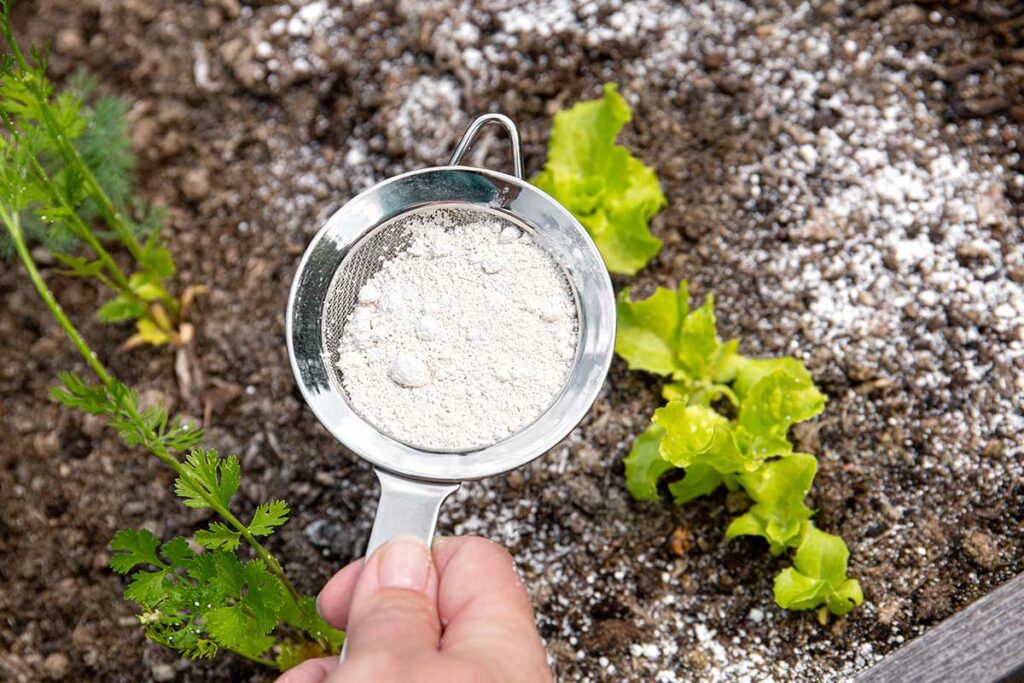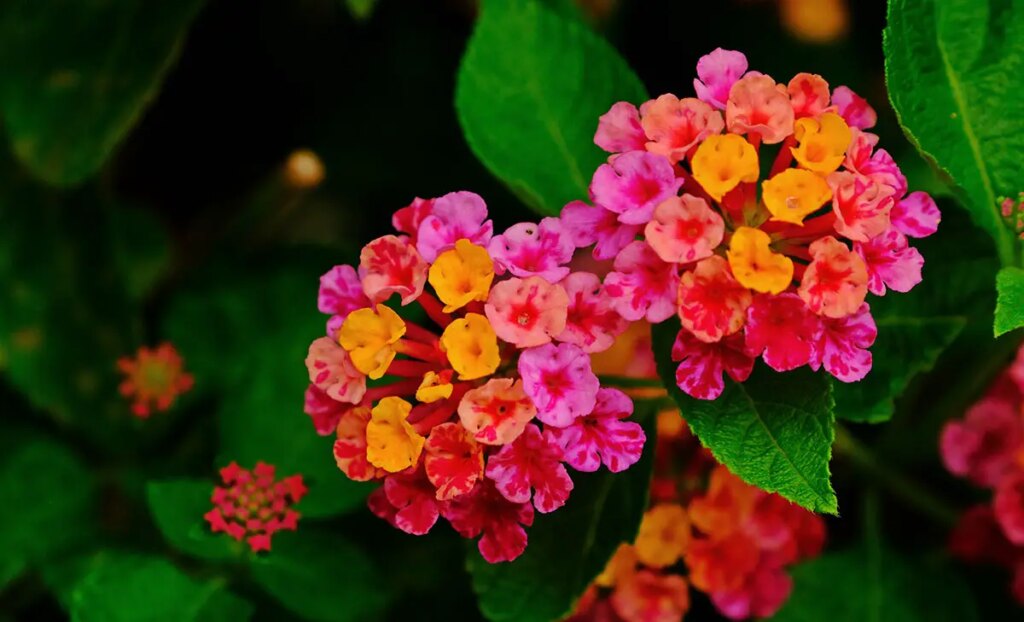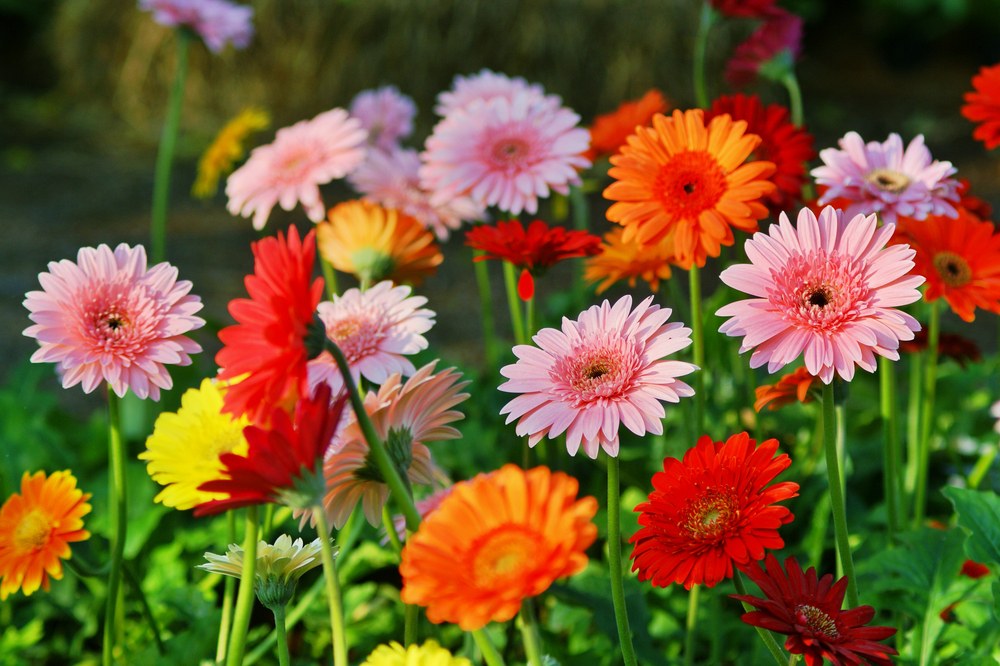
Gardening enthusiasts, have you ever considered the natural alternative of using diatomaceous earth in your gardens?
Diatomaceous earth, a soft, sedimentary rock composed of the fossilized remains of tiny aquatic organisms called diatoms, has numerous benefits to enhance the health and productivity of your plants.
Let’s explore some of the ways it can make a positive impact in your garden.
By incorporating diatomaceous earth into your gardening routine, you’re taking an eco-friendly approach to pest control.
This non-toxic substance helps to eliminate various pests such as slugs, snails, and insects that can potentially damage your plants.
It works by causing the exoskeletons of these pests to dry out, leading to their eventual demise.
They will no longer feast on your precious plants, allowing them to grow and flourish.
Additionally, diatomaceous earth offers benefits beyond pest control. It is known to improve soil quality by promoting better drainage and aeration.
This helps to create optimal conditions for the cultivation of strong, healthy plants with vibrant blooms.
So, the next time you’re planning your gardening strategy, consider the many advantages of using diatomaceous earth in your garden.
Understanding How Diatomaceous Earth Works
Diatomaceous earth (DE) is a natural product made from the fossilized remains of tiny, aquatic organisms called diatoms. When you use DE in your garden, you’re taking advantage of its unique properties that make it an effective pest control method.
As you apply DE to your garden, it’s crucial to understand that it works mainly through a physical process, rather than a chemical one. The diatom fossil’s sharp, microscopic edges are abrasive to pests like insects and slugs. As these pests come into contact with the DE, the tiny particles slice through their exoskeletons or outer layers, causing them to lose essential moisture. This eventually leads to dehydration and death.
Another aspect to consider is that DE can be used both as a dry powder and mixed with water as a spray. When you apply DE powder to your garden soil, it can deter pests like ants and other crawling insects. On the other hand, a DE spray is helpful in reaching those hard-to-access areas where pests might hide. Keep in mind that DE needs to be dry in order to work effectively, which means that you should reapply it after rain or watering.
It’s good to know that DE is safe for beneficial insects like bees and ladybugs, as long as it’s not applied directly to them. This is because these insects have less contact time with the DE-covered surfaces, minimizing potential harm. Plus, DE is non-toxic for humans and pets, making it an eco-friendly pest control option in your garden.
Remember to use food-grade DE in your garden for optimal safety and effectiveness. And don’t forget to wear a mask and gloves while applying DE, as it can cause skin or respiratory irritation for some people. With these precautions taken, you can enjoy the benefits of using diatomaceous earth to keep your garden pest-free and flourishing.
Identifying Pests in the Garden
As a gardener, it is essential to familiarize yourself with common pests that can harm your plants. Early detection can save you time and prevent further damage in the garden. Here are some pointers on how to identify pests in your garden.
To start, inspect your plants regularly. Look for visible signs of damage on the leaves, stems, and fruits. Common signs of pest infestation include:
- Holes or bite marks on the leaves
- Wilting or yellowing of foliage
- Stunted growth or distorted shapes
- Sticky residue or a foul smell
Take note of any insects you spot while inspecting your plants. Some common garden pests and the damage they cause are:
- Aphids: These tiny pests suck the sap out of plant tissues, leading to curled, yellow leaves and stunted growth.
- Spider mites: These cause small, yellow speckles on leaves, which may eventually turn brown or fall off.
- Slugs and snails: These chew large, irregular holes in leaves and can be found on the ground, especially in damp areas.
- Caterpillars: These pests chew holes in leaves or consume entire leaves, and can often be found on the underside of foliage.
When you find pests, don’t panic. Instead, take steps to manage the infestation. One natural option to consider is Diatomaceous Earth (DE). This non-toxic powder can effectively kill many garden pests without harming plants, beneficial insects, or the environment. To use DE, simply sprinkle it onto the affected plants, making sure to cover the leaves and surrounding soil. The pests will come in contact with the DE and die, helping you regain control over your garden. Remember to reapply DE after heavy rainfall or watering to maintain its effectiveness.
Application Methods of Diatomaceous Earth in Garden
Diatomaceous Earth (DE) is a wonderful addition to your garden care routine. It’s easy to apply and provides several benefits. In this section, we’ll discuss some popular methods for applying DE in your garden, so you can choose the one that’s best for you and your plants.
One of the most common ways to apply DE in your garden is by sprinkling it around your plants.
Simply use a small scoop or your hands to lightly distribute the powder over the soil. This method works well for potted plants and garden beds alike.

It’s important to be gentle, as DE can be harmful to some beneficial insects if over-applied.
Another option is to create a DE barrier around your garden. To do this, spread a thin, continuous line of DE around the perimeter of your garden or individual plants. This barrier will help deter pests from entering and can be especially helpful for vulnerable seedlings.
Using a garden duster to apply DE can help you achieve a more even coverage. Fill the duster with DE and then gently squeeze the bulb to release a fine mist of powder. This method is ideal for larger garden areas or if you’re looking to target specific pests, such as aphids or beetles.
Sometimes, pests may be hiding beneath the soil or inside your plants. In these cases, you might want to consider making a DE spray. Mix DE with water in a spray bottle and apply it directly to the affected areas. This method allows you to target specific locations and pests with ease.
Lastly, you can incorporate DE with other garden additives such as compost, organic fertilizers, and even potting soil. This method ensures that DE is present throughout your garden and can provide ongoing benefits to your plants and soil.
Remember to always apply DE to your garden in dry weather, as it loses its effectiveness when wet. Also, it’s important to reapply DE after heavy rain or if you’ve noticed a significant reduction in visible DE around your plants.
Preserving Plant Health with Diatomaceous Earth

Soil Improvement
Diatomite, the natural component of diatomaceous earth (DE), contributes to improving the overall quality of your garden soil. It enhances the soil’s ability to retain moisture and vital nutrients, leading to healthier and more vibrant plants. By using DE regularly, you can reduce the need for chemical fertilizers and promote sustainable gardening practices.
When adding DE to your soil, aim for a 5-10% mixture, depending on your garden’s needs.
Insect Prevention
Diatomaceous earth is a powerful and eco-friendly option for preventing harmful insects and pests in your garden. DE’s abrasive and absorbent properties help control unwanted bugs by dehydrating and eventually killing them.
To effectively use DE as an insect prevention method, follow these steps:
- Identify affecting areas: Check the plants for signs of infestation, focusing on the undersides of leaves and near the base of the stem.
- Apply diatomaceous earth: Lightly dust the affected areas with a thin layer of DE, ensuring even coverage. Reapply after periods of heavy rain or when necessary.
Remember, diatomaceous earth is non-discriminatory, meaning it may also harm beneficial insects. Apply DE selectively and use it as a targeted treatment to minimize any unintended consequences.
Safety Measures for Using Diatomaceous Earth
Before using diatomaceous earth in your garden, it’s important to take a few safety measures. These will ensure both the effectiveness of the product and your own well-being.
First, always wear protective gear when handling diatomaceous earth. This includes gloves, goggles, and a mask. Since the product is a fine, powdery substance, it can irritate your skin, eyes, and lungs if not handled carefully. By wearing the appropriate gear, you can avoid these potential irritations.
Next, only use food-grade diatomaceous earth in your garden. This type is safe for both humans and pets, and it’s proven to be effective in controlling pests. Avoid using the filter-grade or pool-grade versions, as they can contain harmful additives and are not intended for use in gardens.
Keep diatomaceous earth dry when storing and applying it. Moisture will reduce its effectiveness in controlling pests, as the particles will clump together and lose their sharp edges. Apply DE to your garden on a dry day, and store it in an airtight container to maintain its potency.
Furthermore, practice moderation when applying diatomaceous earth in your garden. While it’s effective in combating pests, it can also harm beneficial insects such as bees and ladybugs. To avoid harming these helpful creatures, only apply DE around the base of plants or in areas where you have noticed an infestation.
Finally, be mindful of wind conditions when applying diatomaceous earth in your garden. Blowing DE into neighboring properties may cause issues with your neighbors, as they may not be familiar with the product. Apply DE on a calm day or use a controlled method of application, such as a duster or a puffer, to target specific areas in need of treatment.
By following the above safety measures, you can confidently and effectively use diatomaceous earth in your garden to eliminate pests while protecting yourself and the environment.
Environmental Impact of Diatomaceous Earth

Diatomaceous earth (DE) offers a variety of benefits for your garden, and a key advantage is the minimal environmental impact associated with its use. Since DE is derived from the fossilized remains of diatoms, it’s a natural substance and doesn’t contain harmful chemicals. As a result, it’s safe for both humans and the environment when used as directed.
When you apply DE in your garden, you’ll find that it’s effective in controlling various pests without harming beneficial insects such as bees and butterflies. DE kills pests mechanically, by damaging their exoskeletons, which means it doesn’t have to be toxic to achieve its purpose. This selectiveness helps maintain a healthy ecosystem in your garden.
Another benefit of using DE is that pests don’t develop resistance to it. Since it acts as a mechanical pesticide, it’s unlikely that insects will become resistant, unlike the case with chemical pesticides. This ensures the long-term effectiveness of DE, reducing the need for stronger, potentially harmful alternatives.
DE also has minimal impact on the surrounding environment. It’s insoluble in water, which means it won’t easily dissolve and leach into nearby water sources. While you should still take care to avoid excess runoff when applying DE, it’s far less harmful to aquatic life than synthetic pesticides.
In summary, using diatomaceous earth in your garden is an environmentally friendly and effective way to manage pests. Its non-toxic nature supports a healthy ecosystem while protecting your plants from harm.
Choosing the Right Diatomaceous Earth Product
When selecting a diatomaceous earth (DE) product for your garden, you want to make sure it’s effective yet safe for your plants. Here are a few key points to consider when choosing the right DE product for your garden.
First, always opt for food-grade diatomaceous earth. This type is non-toxic and safe for human and pet consumption, ensuring that it won’t harm your plants or the creatures living in and around your garden. Food-grade DE is also the most effective option for killing insects without causing harm to beneficial insects like earthworms or bees.
Second, consider the particle size. Finer particles of diatomaceous earth will be more effective at getting into the exoskeletons of pests, ultimately killing them. A product with a fine consistency will also be easier to apply, especially for those hard-to-reach areas.
Where to Buy?
Third, while diatomaceous earth comes in several forms, such as powder, pellet, or wettable powder form, it’s essential to choose the right one based on your needs. Powdered DE is the most versatile, as you can dust it on your plants, mix it with water to create a spray, or apply it directly to the soil. Wettable powders and pellets work well for soil applications and can help with moisture control in your garden.
Finally, look for a product with clear application instructions and safety guidelines. Knowing the proper way to apply and store diatomaceous earth will help you maximize its benefits in your garden without any unwanted side effects.
By considering these factors, you’ll be able to choose the right diatomaceous earth product for your garden, effectively managing pests while promoting a healthier and more productive growing environment.
Conclusion
Diatomaceous earth is a versatile and eco-friendly solution for your garden. By incorporating it into your gardening routine, you’ll enjoy healthier and more robust plants. It’s a great alternative to harmful pesticides, protecting your garden from pests while ensuring your plants receive essential nutrients.
In addition, diatomaceous earth is cost-effective and easy to apply. It can be sprinkled around plants or mixed in water to create a spray. Because it’s natural and safe, you can have peace of mind knowing that you’re doing your best to maintain a sustainable garden.
Here are some key takeaways from using diatomaceous earth in your garden:
- Natural pest control: Targets a wide range of pests, making it a go-to choice for organic gardeners.
- Soil improvement: Increases the soil’s capacity to retain moisture, improving overall soil quality and plant health.
- Non-toxic and safe: Safe for you, your plants, and the environment, reducing concerns about potential health risks.
By utilizing diatomaceous earth in your garden, you’ll be promoting the well-being of your plants and the ecosystem. So, go ahead and give it a try – your garden will thank you.
Frequently Asked Questions
How does diatomaceous earth affect garden pests?
Diatomaceous earth works by dehydrating garden pests such as aphids, ants, and slugs. The tiny, sharp particles in diatomaceous earth pierce the exoskeletons of pests and absorb their body fluids, ultimately causing them to dry out and die. Keep in mind, it’s most effective when dry, so you might have to reapply after rain or watering periods.
Can diatomaceous earth be used on indoor and outdoor plants?
Yes, you can use diatomaceous earth on both indoor and outdoor plants. It’s a versatile and non-toxic way to control pests in various environments. When using it indoors, just be cautious about creating dust and always wear a mask to prevent inhalation of the fine particles.
How does diatomaceous earth influence soil quality?
Diatomaceous earth has a positive impact on soil quality, as it contains a variety of essential minerals like silica, calcium, and magnesium. These minerals help improve soil structure and promote healthy plant growth. Additionally, diatomaceous earth can help retain moisture in the soil, which is essential for plant growth and development.
Does diatomaceous earth have any impact on beneficial insects?
Diatomaceous earth can potentially harm some beneficial insects like bees and ladybugs, as it does not discriminate between pests and beneficial organisms. To minimize the impact on beneficial insects, apply diatomaceous earth to targeted areas where you have noticed pest problems and avoid applying it directly on flowers or other areas where beneficial insects tend to congregate.
What is the suggested application frequency for diatomaceous earth in gardens?
The application frequency for diatomaceous earth in gardens can vary depending on factors such as the level of infestation and weather conditions. As a general recommendation, you can apply it every few weeks or as needed, depending on the presence of pests. Remember to reapply after heavy rain or watering, as its effectiveness decreases when wet.
Are there any precautions to take when using diatomaceous earth for vegetable plants?
When using diatomaceous earth on vegetable plants, be cautious not to apply it on the parts of the plants you intend to consume. This is because the sharp particles can be abrasive and cause gastrointestinal discomfort if ingested. Ensure that you wear gloves and a mask when applying it, and always wash your edible produce thoroughly before consumption.














